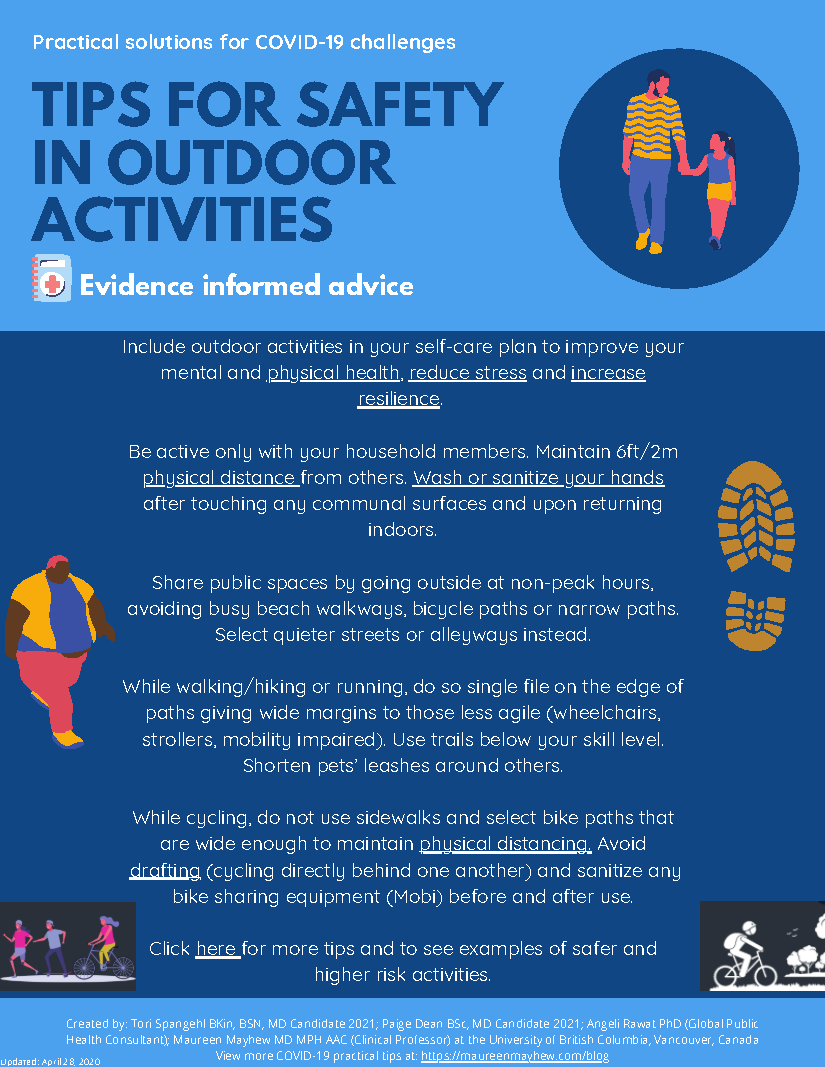Stay home if you have been diagnosed with COVID-19, are exhibiting symptoms that could be COVID-19 or are living with someone who is sick with COVID-19.
Outdoor activities are beneficial to mental and physical health and are an important component of self-care.
Being outside is associated with reducing stress, improving lung function and cardiovascular fitness and reducing problems related to chronic diseases.
Studies have shown that being in nature is associated with more perseverance, problem solving, critical thinking, leadership, teamwork, mindfulness and resilience. In fact, it has also been associated with active citizenship, reduced crime and antisocial behavior.
When outside, wash or sanitize hands after touching communal surfaces.
While COVID-19 could be susceptible to ultraviolet light and not be as easily transmitted outdoors, it is important to continue physical distancing by maintaining at least 2 arms-lengths (6 ft or 2m) and avoid breathing on others.
Tips to maintaining physical distancing during outdoor activities:
Until restrictions are lifted, gather only with your household members.
Do not spit or blow mucous from your nose unless you use a tissue then wash your hands.
Share parks and beaches. Many people want to use outdoor spaces but physical distancing limits the number of people who can go at any one time. Consider other destinations to allow others their turn.
Share rooftop decks, patios or small yards. If crowded, inhabitants may want to create a roster for their use.
Choose to go outside at non-peak times and avoid busy areas such as beach walkways, bicycle paths or narrow paths. Select quieter streets or alleyways instead.
Walk single file on the edge of sidewalks or in the grass to allow others to pass 6ft/2m away from you. When stopping, move to the side of the path to allow others to pass and maintain physical distancing.
Consider walking in the same direction as other walkers like “one ways”.
Consider staggering your path to the left or right of the person in front of you so you are less likely to be exposed to their slipstream. Doing this may not reduce COVID-19 transmission. Studies have not been completed.
Bike on roads or bike paths, not on sidewalks. Yield to those coming downhill on bikes, scooters, wheelchairs or strollers. Only pass when you can maintain a distance of 6ft/2m or more.
Be aware of your surroundings and avoid multitasking or giving all your attention to your phone.
Provide a wide margin around those who are less agile such as people with mobility issues, strollers, wheelchairs etc. Consider stopping at a convenient spot to allow someone else to pass 6ft/2m away.
Shorten a pet’s leash to allow others to pass you and consider whether unleashing your pet will affect other people’s enjoyment of a space.
Some outdoor activities are safer than others:
Choose to participate in low risk activities which reduce the likelihood of injuries requiring medical care or hospitalization. Stay close to home to avoid car accidents and triggering search and rescue efforts.
Low risk outdoor activities can be done in your yard, balcony or patio. Examples include: gardening, Pilates, meditation, yoga or doing your workout outside.
Jogging, walking and cycling on quiet roads are considered low risk activities. Cyclists should avoid drafting (cycling directly behind one another). Consider cycling along roads or wide bike paths that allow options for physical distancing. If using a shared bike rental service such as Mobi sanitize all high contact points (helmet, handlebars, baskets, seat, locks) both before and after use. Consider using your own helmet. Wash or sanitize your hands after using the bike.
High intensity physical exercise such as sprinting and cycling hard can cause spit droplets to be propelled further than 6 ft/2m. Although the risk of COVID-19 transmission during a brief encounter is low, when doing any intense activity we suggest maintaining a distance between you and others of more than 6ft/2m.
Some people may choose to Nordic ski near their homes on easy terrain.
If hiking, only use trails well below your skill level, prioritize safety and avoid trails with shared ropes and ladders. Do not hike in the backcountry at this time. Familiarize yourself with current parks and trails closures. Hikers ascending trails have the right of way. Ensure that you stop at appropriate points, off the trail if necessary, to maintain physical distance of 6 feet from other hikers.
Avoid higher risk activities.
Sports that involve touching common surfaces such as basketball, volleyball or frisbee.
Sports in which physical distancing can’t be maintained such as group exercise classes or dragon boating.
Parks and ski resorts in BC are currently closed.
To protect search and rescue volunteers and minimize accidents that may result in hospitalizations, skiing, snowshoeing or hiking in the backcountry is not recommended even if you are experienced.
Water sports such as canoeing, kayaking, surfing, kiteboarding, stand up paddle boarding or swimming are best avoided unless they can be done near your home in easy conditions. Your care protects lifeguards, search and rescue volunteers and healthcare workers.
Hunting is not recommended because it requires travel and has a high potential for injuries.
Exercises that the elderly might consider (as little as 10 minutes 3 times a day) might include:
Nordic walking which involves hiking poles and provides a total body workout.
Move for life program includes energy bursts and walkabouts
Created by: Tori Spangehl BKin, BSN, (MD Candidate 2021); Paige Dean BSc, (MD Candidate 2021); Angeli Rawat MPH PhD (Global Public Health Consultant); Maureen Mayhew MD MPH AAC (Clinical Professor) at the University of British Columbia, Vancouver, Canada

